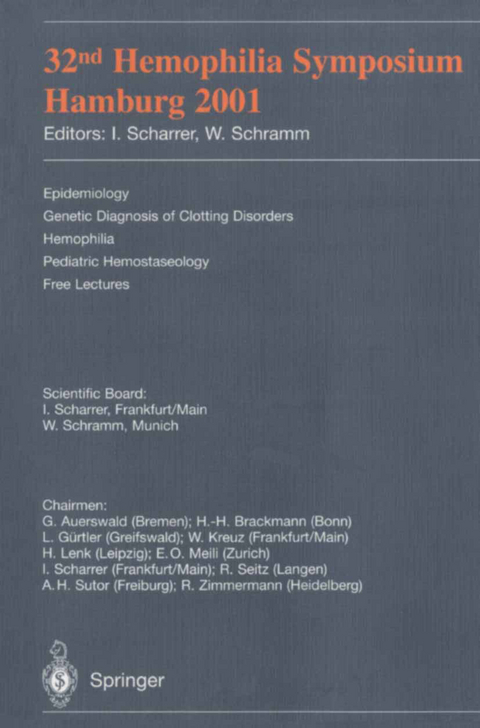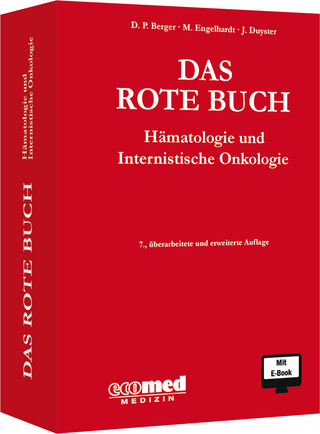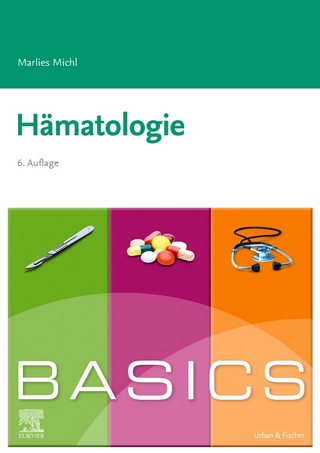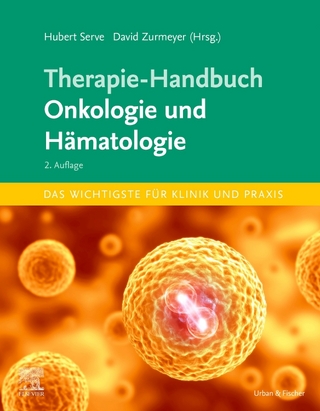
32nd Hemophilia Symposium Hamburg 2001
Springer Berlin (Verlag)
978-3-540-43884-7 (ISBN)
I. Epidemiology.- HIV Infection and Causes of Death in Patients with Hemophilia in Germany (Year 2000/2001 Survey).- Hemophilia 2001 - The Annual Survey of the Austrian Hemophilia Centers.- Epidemiology of Hemophilia in Switzerland: A first Insight in the Data Base achieved by the Medical Committee of the Swiss Hemophilia Association.- Overall Blood Supply Strategy with Regard to vCJD.- II. Genetic Diagnosis of Clotting Disorders.- a) Human Genome Project.- 11 novel Mutations in the Factor VIII encoding Gene lead to severe or moderate Hemophilia A.- b) Register and Genetic Diagnosis.- Molecular Analysis of Hemophilia B: »Greifswald Registry FIX Deficiency (Hemophilia B)«.- Gly222Asp and Ser379Lys - Novel Factor X Gene Mutations in severe FX Deficiency - Greifswald Registry of Factor X congenital Deficiency.- c) Gene Therapy.- Hematopoietic Stem Cells as Targets for Gene Therapy of Hemophilia A.- Adenovirus-mediated regulatable Expression of human Factor IX in vitro and in vivo.- III. Hemophilia.- a) Orthopedics.- Experiences with MRI Examination of the Joints of hemophilic Children.- Rhenium-186 Hydroxyethylidenediphosphonate (186Re HEDP) - A novel Treatment for hemophilic Arthropathies?.- b) Monitoring of Substitution Therapy.- Monitoring of Anticoagulant Therapy with the Endogenous Thrombin Potential.- IV. Pediatric Hemostaseology.- First thromboembolic Onset in Children carrying either the heterozygeous FV G1691A Mutation or the Prothrombin G20210A Variant.- UFH Bolus Administration in Comparison to subcutaneous Low Molecular Weight Heparin in pediatrie cardiac Catheterization.- Incidence of Inhibitor Development in consecutively recruited severe Hemophilia A and B Patients - a retrospective Single Centre Study.- V. Free Lectures.- FV Inhibitor andAnti-Phospholipid Antibodies after Treatment with Ciprofloxacin.- Isolated molecular Defects of von Willebrand Factor Binding to Collagen do not correlate with Bleeding Symptoms.- Effects of Tissue Factor Pathway Inhibitor and Antithrombin on Thrombin Generation in Tissue Factor-activated Cord Plasma.- Early and Rapid Diagnosis of acute TTP by Measuring Activity of von-Willebrand Factor Cleaving Metalloprotease (ADAMTS13): A Case Report.- Prions and the Safety of Plasma Proteins: Preventive Measures and Research Activities.- VI. Poster.- a) Clinic and Casuistic.- Transmission of Parvovirus B19 by Heat-treated Coagulation Factor Concentrates.- Course of severe Hemophilia A. Successful Immune Tolerance Therapy (ITT) ten Years after Inhibitor Development.- Increased Resistance to activated Protein C and Protein C Deficiency in the same Family.- A Life-threatening Cardiomyopathy following Port-a-Cath Infection under Immune Tolerance Therapy.- Therapy and Prophylaxis of Bleeding Symptoms in a Patient with Acquired Factor X-Deficiency due to Systemic Amyloidosis (AL-Amyloidosis).- Is there a Correlation between vWF-cleaving Protease-Activity, vWF:Ag, Clinical Course and Number of Relapses in 15 Patients with TTP?.- Life-Threatening Hemorrhage in a Patient with Red Cell Antibodies - Effective Blood Coagulation with rFVIIa.- Liver Transplantation in a HIV/HCV coinfected Hemophilia A Patient.- Dysfibrinogenemia following after Snake Bite.- Bleeding Complications following Tooth Extraction in a Hemophilia A Patient with Inhibitor - A Case Report.- Cerebral Sinus Thrombosis: Recanalization after intravenous Dalteparin Administration.- b) Hemophilia and Hemorrhagic Disorders.- Treatment of FVIII-Autoantibodies by Protein A-Based Immunoadsorption and Immunosuppression: ARegimen without FVIII Substitution.- Factor XI Deficiency caused by a hitherto unknown Mutation in the Factor XI Gene.- Polymorphisms in FV Gene associated with FV Deficiency - First Results.- Influence of Phospholipids of the Platelet Membrane of Newborns on the Thrombin Generation.- Socio-economic Evaluation of Hemophilia Assistance.- Aspects regarding Locomotor Rehabilitation of Hemophiliacs.- c) Thrombophilic Disorders.- Prothrombin and Factor VII Genotypes and Phenotypes in healthy Individuals. Results from the Lugen Study.- Factor V Leiden and Other thrombotic risk factors in CHD and myocardial Infarction.- In vitro Effects of combined Administration of Epitifibatide and Anticoagulants on Thrombin induced Platelet Aggregation after high versus low Coagulant Activation of Platelet Rich Plasma.- Cardiac and cerebral Manifestations of the Antiphospholipid Syndrome.- d) Diagnosis.- Inactivation of Animal Factor VIII by human Factor VIII Inhibitors: Special Methodological Features in Performing the Factor VIII Assay and the Bethesda Assay.- Inactivation of Animal Factor VIII by human Factor VIII Inhibitors: Investigation of Plasma from Patients with Inhibitors in congenital Hemophilia A and from Patients with acquired Hemophilia A.- Factor VIII:C Measurement - Comparison between Chromogenic and Coagulometric Methods in Hemophilia A - Patients with the B Domain-depleted Recombinant F VIII-Preparation ReFacto.- Functional Assessment of fibrinolytic Resistance in whole Blood.- e) Miscellaneous.- Quality Control of Platelet Concentrates during Storage Using Different Forms of Agitation Measuring the Platelet Activation.- Platelet Activation before and after Cryopreservation of Platelet Concentrates with a New Storage Solution.- Flow Cytometric Measurement of CD34+Cells: How reliable are absolute Cell Counts generated by the Integration of Beads?.- An Innovative Approach to Teach and Learn Diagnostic Skills and Therapeutical Management of Coagulation Disorders: CAMPUS - an Interactive, Computer- and Case-Based Program.- Expression of Protease-activated Receptors in Neuroblastoma Cells.
| Erscheint lt. Verlag | 23.10.2002 |
|---|---|
| Zusatzinfo | XXIX, 318 p. 112 illus. |
| Verlagsort | Berlin |
| Sprache | englisch |
| Maße | 155 x 235 mm |
| Gewicht | 560 g |
| Themenwelt | Medizinische Fachgebiete ► Innere Medizin ► Hämatologie |
| Schlagworte | Hämophilie • Hemophilia • Hemorrhagic diathesis • pediatric hemostasiology • Sepsis • thrombophilic diathesis |
| ISBN-10 | 3-540-43884-X / 354043884X |
| ISBN-13 | 978-3-540-43884-7 / 9783540438847 |
| Zustand | Neuware |
| Haben Sie eine Frage zum Produkt? |
aus dem Bereich


